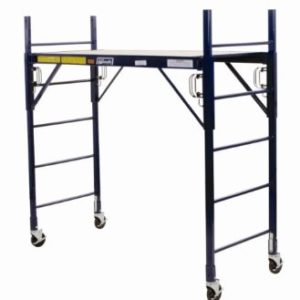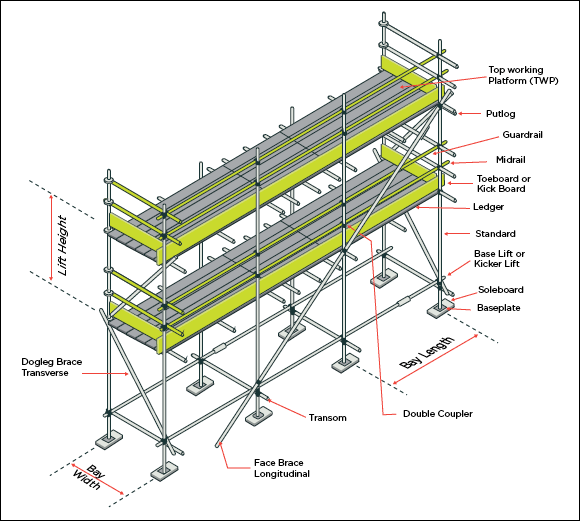The Composition of a Scaffold: Recognizing Its Components
To comprehend the anatomy of a scaffold, concentrate on its crucial functions like providing security for workers at diverse heights and making certain task effectiveness. Parts include steel, light weight aluminum, or timber materials developed for security and security. Scaffold frameworks come in various kinds and materials, with flexible elevations and cross-bracing for assistance. Platforms are critical for worker safety, calling for correct weight circulation and safe and secure attachment. Precaution require cautious assessment, safe base plates, guardrails, and regular checks. Discovering these elements even more enhances understanding of scaffold construction and safety and security procedures.
Key Functions of a Scaffold
What essential functions does a scaffold play in various construction tasks?
The functions of a scaffold are important in giving a safe and effective workplace for building and construction employees. The structure of a scaffold is created to sustain workers, products, and devices at raised elevations during building, upkeep, or fixing tasks. Security is a key problem when it pertains to scaffolding, and regulations are in place to assure that scaffolds are set up, made use of, and dismantled properly to avoid mishaps and injuries.
One vital function of a scaffold is to give a steady platform for employees to carry out tasks at various heights. The structure of the scaffold must be strong and safe and secure to sustain the weight of workers and materials. Additionally, scaffolds enable workers to access hard-to-reach locations of a building or framework safely. By following safety guidelines and standards, such as using appropriate loss security equipment and evaluating the scaffold frequently, building and construction jobs can be completed successfully and without events.
Key Components of a Scaffold
Scaffolds contain numerous major components that are essential for guaranteeing the stability and safety and security of elevated work systems in building and construction projects. The major elements of a scaffold include scaffold products and scaffold layout. Scaffold materials differ based on the requirements of the construction project and can include steel, aluminum, wood, or a mix of these products. The scaffold design encompasses the layout and structure of the scaffold, ensuring it can support the desired lots safely.
The choice of scaffold products is vital in figuring out the toughness, sturdiness, and general security of the scaffold. Steel scaffolds are recognized for their robustness and ability to support hefty lots, making them suitable for big construction jobs. Light weight aluminum scaffolds, on the other hand, are lightweight yet durable, making them optimal for projects that call for regular repositioning. Timber scaffolds are commonly utilized for smaller sized projects as a result of their cost-effectiveness.
In scaffold style, aspects such as the scaffold's elevation, weight capability, and configuration are very carefully taken into consideration to meet safety and security laws and task requirements. Appropriate scaffold layout is important to protect against crashes and ensure a safe and secure working environment for building employees.
Recognizing Scaffold Frames
Recognizing the architectural framework of scaffold systems is important for making certain security and safety on construction websites. Scaffold frames play an essential role in offering the needed support for workers and products at various heights. To comprehend the idea better, think about the complying with bottom line concerning scaffold frameworks:
- Kinds of Frames: Scaffold structures can be found in numerous types such as walk-through frames, ladder structures, and stonework frameworks, each serving details functions on building and construction websites.
- Product Make-up: Frameworks are generally built from steel or aluminum, offering resilience and stamina to support the scaffold framework. stair access scaffolding
- Interlacing System: Lots of scaffold frameworks include an interlocking system that permits very easy assembly and disassembly, improving performance on-site.
- Adjustable Heights: Some frame kinds use adjustable height settings, allowing employees to customize the scaffold to match various task requirements.
- Cross-Bracing for Security: Cross-bracing is typically included right into structure designs to improve scaffold security and protect against persuading or tipping throughout use.
Recognizing these aspects of scaffold frameworks is vital for making certain a secure and trusted workplace on building tasks.
Significance of Scaffold Operatings Systems
Taking a look at the pivotal function of scaffold platforms in making sure architectural honesty and safety and security at raised worksites is vital for construction experts.
Scaffold systems work as the essential horizontal structures where workers stand, move, and do jobs. Platform security is paramount, as it directly influences the safety and security of employees and the success of the building and construction task.
Correct weight circulation on scaffold platforms is critical to stop overloading, which can cause platform failure and crashes. Guaranteeing that systems can sustain the designated lots capability is necessary in keeping a risk-free working environment.
Additionally, scaffold systems should be safely connected to the scaffold structure to stop any type of activity or instability during use. Construction professionals must thoroughly evaluate scaffold platforms before each use to determine any type of indicators of damage or wear that can jeopardize their stability.
Safety Measures for Scaffold Setting Up
Taking into consideration the critical nature of scaffold stability and platform integrity, the implementation of stringent safety measures throughout scaffold assembly is vital to reduce dangers and guarantee a protected workplace. Following safety and security standards and making sure proper training are basic facets of scaffold setting up. Below are 5 key safety measures to comply with:
- Check Tools: Prior to setting up, completely check out all scaffold parts for any type of damages or issues that can compromise safety and security.
- Secure Base Plates: Ensure that base plates are firmly placed on a strong surface to give stability and avoid tipping.
- Use Guardrails: Set up guardrails on all open sides and ends of the scaffold to prevent falls and improve worker security.
- Correctly Planked Systems: Scaffold systems ought to be correctly planked with products with the ability of supporting intended lots to avoid architectural failings.
- Normal Safety Checks: Conduct regular security evaluations throughout assembly to recognize and deal with any safety threats immediately.
Often Asked Concerns
Are There Any Regulations or Standards for the Maximum Elevation a Scaffold Can Be Developed To?
Scaffold security is essential in ensuring safety on building and construction sites. Elevation guidelines determine the optimum acceptable elevation for scaffolds to maintain architectural stability. Safety preventative measures, such as regular examinations and adherence to standards, are essential, specifically in severe weather conditions.
Can Scaffolds Be Used in Extreme Climate Issues Such as Hefty Rainfall or Snow?
Scaffolds can be utilized in extreme weather conditions with correct preventative measures. Waterproofing approaches like covering with tarps and sealing joints can shield against hefty rainfall. Winter safety measures include making use of non-slip surface areas and making certain security in snow.
Exactly How Frequently Should Scaffolds Be Examined for Wear and Tear or Damage?
Scaffolds ought to be checked consistently in accordance with safety and security standards to ensure architectural honesty. Assessment regularity depends on use, with most guidelines suggesting weekly checks. Regular maintenance methods are crucial for identifying deterioration or harm quickly.
Are There Any Specific Weight Limits for Scaffolds to Guarantee Security?

Weight limits for scaffolds are essential to ensure security on construction sites. Safety and security laws typically dictate specific weight capacities for different types of scaffolding based upon their layout and materials. Following these limits is crucial.

What Are Some Common Blunders or Mistakes to Avoid When Putting Together a Scaffold?
When building a scaffold, essential mistakes to prevent consist of improper supporting, ignoring secure footing, utilizing harmed parts, exceeding weight limits, and neglecting safety standards. Assurance detailed training, regular examinations, and compliance with laws.
Conclusion
To sum up, understanding the key functions and components of a scaffold, consisting of frameworks and platforms, is important for guaranteeing safety during assembly.
By adhering to precaution and standards, employees can efficiently make use of scaffolds for various building and construction tasks.
It is essential to focus on the appropriate assembly and maintenance of scaffolds to prevent accidents and guarantee a safe and secure workplace.
